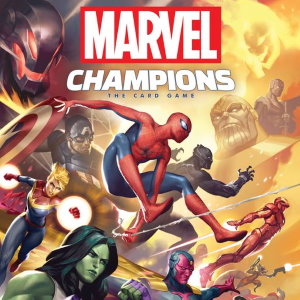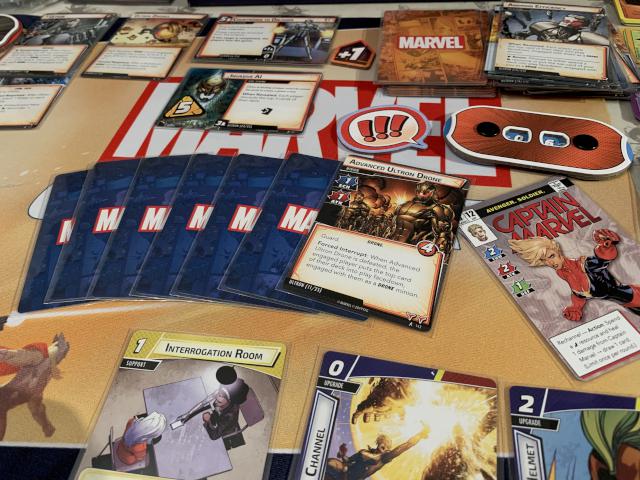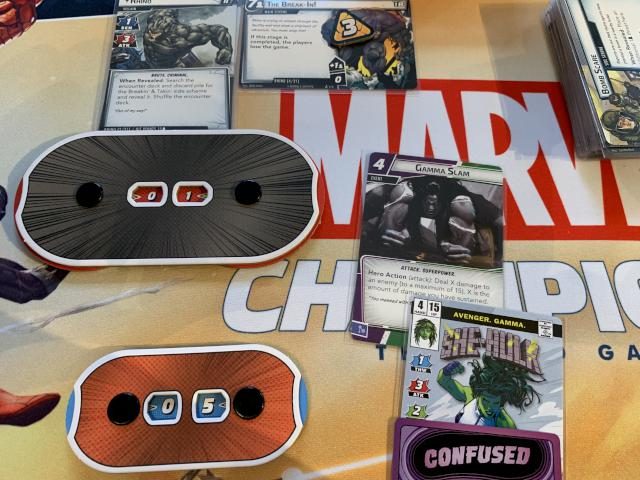
Two of my favourite things at the moment are the Marvel films (yes I love the comics too, but don’t read anything like as many as I used to), and Arkham Horror, the co-operative card game from Fantasy Flight Games.
FFG have a history of creating very popular “Living Card Games” (LCGs)- these differ from the collectible card games like Magic, Pokemon, etc, in that they are generally released as a base core set for two players, followed by a series of expansions contained a fixed set of cards. There is no random element, everyone has access to the same card pool, then you build your decks and play.
So when FFG announced that they were designing a new co-operative LCG, based on the Marvel license, given their pedigree of producing well supported co-operative card games with long-term expansion plans, and the sheer ubiquity of the Marvel brand right now, then this has the potential to be huge.
The game itself is a co-operative card game, where each player chooses a hero, constructs their deck in advance, and then faces a villain, trying to defeat them before they are able to complete their nefarious schemes.
The core set gives you an interesting mix of characters to choose from – the more well known (thanks to the films) Spider-Man, Iron Man, Black Panther and Captain Marvel, plus fan-favourite She-Hulk. To complete your hero deck, you add cards from one of four “aspects” (Justice, Protection, Aggression and Leadership) – only one of these can be selected, each of which synergises differently with each hero – top these up with some basic cards to give yourself a 40-50 card deck. Lastly, each hero has an “obligation” card that gets shuffled into the enemy encounter deck, each of which has the potential to distract you from the fight – such as Peter Parker’s rent, or T’Challa’s affairs of state. You also have a nemesis, with their own schemes which can sometimes be triggered if a specific enemy card is played.

If you are not interested in deckbuilding, the quantities of cards in the core set (for the first time, containing enough cards for four players, resolving a long-standing complaint about FFG LCGs) let you just grab a her, grab an aspect, and grab a set of basic cards, and you have a playable deck. But there is also room for deckbuilding fans to tweak the deck contents, and find synergies between cards, with the variable deck limit allowing them to thin their decks to increase the chances of certain cards coming out.
Up against you in ascending order of difficulty, are Rhino, Klaw and Ultron. Each of these come in Standard and Expert versions, and like the heroes, each has their own deck. Add in one of four modular enemy sets, plus a standard or expert encounter set, and now you have your villain deck ready to face off against your heroes.
One unique feature of the game is that you are not just your hero. Once per turn, you can flip between alter-ego and hero side of the card, each with their own abilities. While you are in alter-ego form, you are safe from attack, and can heal yourself, but this leaves the villain free to progress his schemes. Switch to hero mode, and you can attack the villain, or attempt to thwart the scheme. If the villain is defeated you win, but if they complete their scheme, you lose, so it is a constant juggling act between saving your own skin, fighting the villain, and thwarting the scheme.
One unique refinement of the LCG format, is that FFG have done away with having to earn resources and spend them to play cards. Instead, each card has a cost printed at the top, and resource icons at the bottom. So to play a 3 cost card, I actually have to discard cards with three resources on them. This can lead to some infuriating decisions, as you have to discard a really good card to play another one.
Some of these cards will be one-off events, some will be upgrades to your hero (for example, to be effective as Iron Man you have to spend several rounds “building your suit” by playing your rocket boots, repulsive gloves, arc reactor (etc), which can mean a slow start, but you are really powerful by the end, Others can be equipment they can use, or a location that supports them (such as Avengers Mansion), these remain in play and give you bonuses or additional actions each turn. You can also play allies, who are effectively design to only stick around for a round or two (they mainly take damage for attacking or thwarting, so can only do this a few times before they are defeated).

On the villain phase, threat is added to the main scheme, then the villain either schemes some more (if you are in alter-ego mode), or attacks you (in hero mode). Then each player draws an encounter card and resolves it – this could be a minion entering the fight, an event you have to deal with, or a side-scheme coming into play which gives you even MORE threat to deal with. So before long you can be overwhelmed with schemes to thwart and enemies to fight, but it rarely feels unbalanced, there is almost always something you can do. And if you are defeated, it is still damn good fun trying.
The gameplay itself is largely inspired by the Lord of the Rings card game, which has been running since 2011 and at last count had somewhere in the region of 140+ expansions for it, so fans are hoping this has similar long legs. Already four expansion packs have been formally announced (Green Goblin, Captain America, Wrecking Crew and Ms Marvel) all of which will be out by February, with monthly releases going forward.
With most LCGs, expansions are often part of a longer campaign, committing you to buying multiple packs if you want to see the story out. In keeping with the refinement and simplification of the format, each villain expansion is a self-contained scenario to play, each hero expansion is effectively a self-contained playable deck (hero deck plus one specific aspect). This more modular nature let’s you pick-n-mix and presents much more flexibility. Not interested in Green Goblin? Skip it. Have a friend who loves Ms Marvel? Get them to buy that deck, and they can join your games just with that single pack. This modular approach really reduces the barrier to entry – just buy what you want without feeling like you’re missing a chunk of the game.
So in summary then, this is a polished refinement of the co-operative LCG format, with simplified flexible expansion plans, for a hugely popular franchise. It’s not cheap (RRP £60) but the modular nature and multiple difficulty levels gets you get a huge amount of replayability for your money with no two games ever playing the same. But most importantly, it is incredibly good fun to play, which let’s face it, is the most important thing you want out of a game!

Leave a Reply